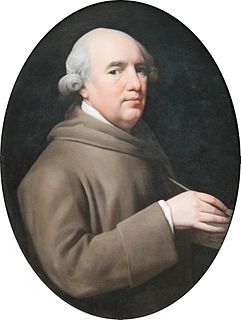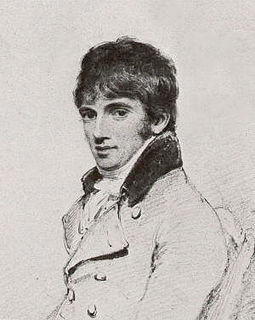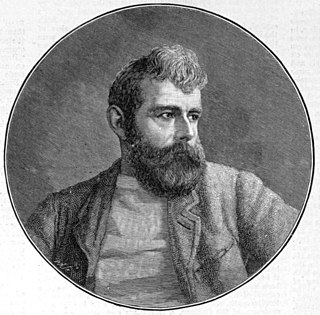
Joseph Mallord William Turner, known in his time as William Turner, was an English Romantic painter, printmaker and watercolourist. He is known for his expressive colourisations, imaginative landscapes and turbulent, often violent marine paintings. He left behind more than 550 oil paintings, 2,000 watercolours, and 30,000 works on paper. He was championed by the leading English art critic John Ruskin from 1840, and is today regarded as having elevated landscape painting to an eminence rivalling history painting.

Thomas Phillips RA was a leading English portrait and subject painter. He painted many of the great men of the day including scientists, artists, writers, poets and explorers.

James Northcote was a British painter.

George Stubbs was an English painter, best known for his paintings of horses. Self-trained, Stubbs learnt his skills independently from other great artists of the 18th century such as Reynolds or Gainsborough. Stubbs' output includes history paintings, but his greatest skill was in painting animals, perhaps influenced by his love and study of anatomy. His series of paintings on the theme of a lion attacking a horse are early and significant examples of the Romantic movement that emerged in the late 18th century. His painting, Whistlejacket hangs in the National Gallery, London.

William Daniell (1769–1837) was an English landscape and marine painter, and printmaker, notable for his work in aquatint. He travelled extensively in India in the company of his uncle Thomas Daniell, with whom he collaborated on one of the finest illustrated works of the period – Oriental Scenery. He later travelled around the coastline of Britain to paint watercolours for the equally ambitious book A Voyage Round Great Britain. His work was exhibited at the Royal Academy and the British Institution and he became a Royal Academician in 1822.
Sophie Gengembre Anderson was a French-born British artist who specialised in genre painting of children and women, typically in rural settings. She began her career as a lithographer and painter of portraits, collaborating with Walter Anderson on portraits of American Episcopal bishops. Her work, Elaine, was the first public collection purchase of a woman artist. Her painting No Walk Today was purchased for more than £1 million.
Sheila Fell was an English artist. She was born at Aspatria, Cumberland in 1931. Although she lived in London for the greater part of her life, she devoted her career to painting the Cumberland landscape.

Henry Moore was an English marine and landscape painter.

Norman Wilkinson was a British artist who usually worked in oils, watercolours and drypoint. He was primarily a marine painter, but also an illustrator, poster artist, and wartime camoufleur. Wilkinson invented dazzle painting to protect merchant shipping during the First World War.

Robert Salmon was a maritime artist, active in both England and America. Salmon completed nearly 1,000 paintings, all save one of maritime scenes or seascapes. He is widely considered the Father of American Luminism.
Thomas Whitcombe was a prominent British maritime painter of the Napoleonic Wars. Among his work are over 150 actions of the Royal Navy, and he exhibited at the Royal Academy, the British Institution and the Royal Society of British Artists. His pictures are highly sought after today.

Alfred Walter Williams was an English landscape painter during the Victorian era, and a member of the Williams family of painters.
William Tate was an English portrait painter who was a student of Joseph Wright of Derby.

Samuel Scott was a British landscape painter known for his riverside scenes and seascapes.

William Lionel Wyllie also known as W. L. Wyllie was a prolific English painter of maritime themes in both oils and watercolours. He has been described as "the most distinguished marine artist of his day." His work is in the Tate, the Royal Academy, the Imperial War Museum, the National Maritime Museum, the National Museum of the Royal Navy, and many other institutions around the world.
Frank Henry Mason, RBA, RI, RSMA was an English artist best known for his maritime, shipping, coastal and harbour paintings, and as a creator of art deco travel and railway posters. His style is described as "light impressionist" and he was a founder member of the Staithes Art Club whose members are known today as the Staithes group of artists, or the Northern Impressionists.

Samuel Drummond was a British painter, especially prolific in portrait and marine genre painting. His works are on display in the National Portrait Gallery, the National Maritime Museum and the Walker Art Gallery.

Walter William Ouless was a British portrait painter from Jersey. He became an Associate of the Royal Academy (ARA) in 1877 and a full member (RA) in 1881.
Michael Sandle is a British sculptor and artist. His works include several public sculptures, many relating to themes of war, death, or destruction.

Richard Wright was an English marine painter. An entirely self-taught artist, he first appeared as an exhibitor in London in 1760, and between that date and 1773 exhibited twenty-five works with the Incorporated Society of Artists and one with the Free Society.














